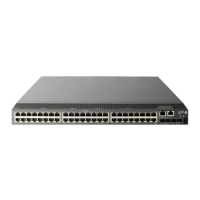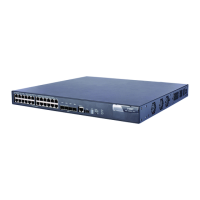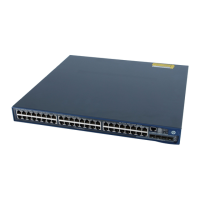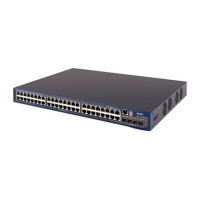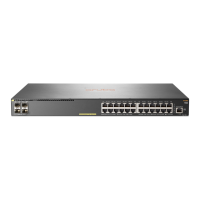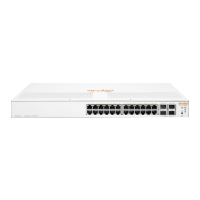55
NOTE:
An IRF fabric can have up to 10 switches. As your business grows, you can plug a switch into an IRF fabric to
increase the switching capacity without any topology change or replacement.
When you set up an IRF fabric that has both A5800 and A5820X switches, see
HP A5820X/A5800]
Heterogeneous IRF Feature Guide
. A heterogeneous IRF fabric supports different specifications for some features
than a homogeneous IRF fabric.
Identifying the master switch and planning IRF member IDs
IRF member switches will automatically elect a master. You can affect the election result by assigning a
high member priority to the intended master switch. For more information about master election, see HP
A5820X & A5800 Switch Series IRF Configuration Guide.
Determine which switch you want to use as the master for managing all member switches in the IRF
fabric. An IRF fabric has only one master switch. You configure and manage all member switches in the
IRF fabric at the command line interface of the master switch.
Prepare an IRF member ID assignment scheme. An IRF fabric uses member IDs to uniquely identify and
manage its members, and you must assign each IRF member switch a unique member ID.
Planning IRF topology and connections
You can create an IRF fabric in daisy chain topology, or more reliably, ring topology. In ring topology, the
failure of one IRF link does not cause the IRF fabric to split as in daisy chain topology. Rather, the IRF
fabric changes to a daisy chain topology without interrupting network services.
You connect the IRF member switches through IRF ports, the logical interfaces for the connections between
IRF member switches. Each IRF member switch has two IRF ports: IRF-port 1 and IRF-port 2. An IRF port
goes up when you bind the first member physical port to it.
When connecting two neighboring IRF member switches, you must connect the physical ports of IRF-port
1 on one switch to the physical ports of IRF-port 2 on the other switch.
The switches can provide 10-GE IRF connections through SFP+ ports, and you can bind several SFP+
ports to an IRF port for increased bandwidth and availability.
Figure 64 and Figure 65 show the topologies of an IRF fabric made up of three A5800-24G switches that
use the LSW1SP4P0 interface card for IRF connections. The IRF port connections in the two figures are for
illustration only, and more connection methods are available.
NOTE:
For information about the physical ports available for IRF connections on the switches, see Table 11.

